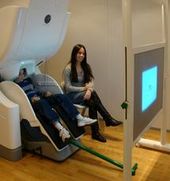
© AhtamResearcher Banu Ahtam guides 9 year old Oscar Nathan through the study.
Oxford University scientists are using brain-scanning technology to understand how we learn to recognize and 'read' faces as children.
The research will also investigate whether there are any differences in the way people with autism spectrum disorders respond to seeing faces.
'Faces are really very similar in their basic features, but we are very good at recognizing different faces instantly. The brain has to be very specialized to be able to do this quickly and accurately,' says Dr Jennifer Swettenham, who is leading the study.
The ability to recognize faces is very important for communication and socializing. We need to be able to recognize people's facial features, and also understand their emotions, respond to where they are looking, and many other signs and indications.